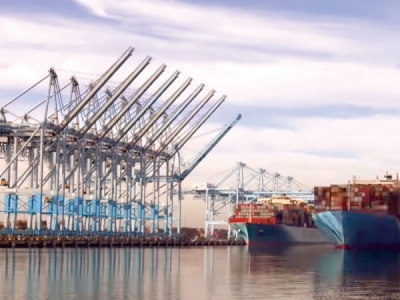
Posted on April 27, 2020
The nation’s major ports suffered the full economic impact of the coronavirus in March as global trade practically came to a halt.
Officials with the Alexandria, Va.-based American Association of Port Authorities said the demand just isn’t there.
“People aren’t buying patio furniture for their backyards and things like that, so there is just softening demand,” AAPA CEO Chris Connor told Transport Topics. “The reality is more in the neighborhood for the big container ports to be down 20%. That is the outlook for the time being.”
The nation’s busiest port, the Port of Los Angeles, saw 20-foot-equivalent unit (TEU) containers plummet 30.9% to 449,568 from 650,977 the previous March.
Cargo volume for the first quarter was down 18.5% year-over-year.
Port officials said production in China is beginning to recover. The nation is key to manufacturing and imports for the United States, where orders are still down and the economy is feared on the verge of falling into a deep recession.
“The loss of work is a hardship for many here around the port and our families,” said Eugene Seroka, executive director at the Port of Los Angeles.
Nearby Port of Long Beach, the No. 2 facility, also experienced a lesser TEU drop of 6.4%, processing 517,663 containers compared with 552,821 the previous March.
“The coronavirus is delivering a shock to the supply chain that continues to ripple across the national economy,” said Mario Cordero, executive director of the Port of Long Beach.
IHS Markit Transportation economist Paul Bingham said the reason the Los Angeles port’s drop was more dramatic comes down to available space since shippers often consider the giant facilities as one.
“It’s a juggling act. The shipping alliances now have terminals oftentimes in both ports. It’s sometimes a creature of which terminal you’re calling within the same alliance,” he said.
Further north along the California coast at the Port of Oakland, monthly TEUs fell 11.1% to 190,189 from 213,972 in the same period a year ago.
One of the main reasons for the slide, officials said, is because the number of ships calling on the facility also is down by 10.6% when compared with March 2019.
The Northwest Seaport Alliance, which operates the ports in Seattle and Tacoma, Wash., reported a 21.6% plunge in TEU volume to 264,133 from 336,828.
The Houston port posted an 11% drop in containers, processing 248,840 TEUs, compared with 280,721 a year ago.
“We also must support the economy with the necessary infrastructure to rebound when this global pandemic is brought under control,” Port Executive Director Roger Guenther said.
On the East Coast, the Port of Virginia’s TEU volume was down 8.6% to 219,315 in March from 240,035 last year. And the outlook is not strong.

The Port of Virginia. (Luke Sharett/Bloomberg News)
Officials there said it will close the Portsmouth Marine Terminal on May 4, as shipping volume decreases amid the coronavirus pandemic. Officials said ships that generally used the Portsmouth terminal would instead be moved to two nearby container terminals, and the terminal can be reopened if and when container volumes begin to show an increase.
“The lack of demand driven by COVID-19 has resulted in ocean carriers reducing their network sailings by 20% for the second quarter of 2020, and we know our volume will remain weaker during this period,” Virginia Port Authority CEO John Reinhart said. “There are still some tough weeks ahead, and we don’t have high expectations for April volume.”
The Port of Savannah, Ga.’s processed TEUs dropped by 74,537 containers, or 18.1%, to 335,789 compared with 410,326 a year ago.

Connor
The Port of Charleston, S.C., saw container volumes drop by 13.3% to 185,631 TEUs compared with 214,113 last year. And port officials also decreased projections for the rest of the year while looking to cut costs by 10%, or $20 million, with no layoffs of full-time staff.
“We are incredibly grateful to our port employees and all those working in the maritime and logistics community for their dedication to ensuring cargo — food, supplies, and medical equipment — is efficiently delivered to communities,” South Carolina Ports Authority President Jim Newsome said.
AAPA’s Connor is optimistic that in the long run, the ports will recover. “We’re feeling it right now, and there’s a lot of pain,” he said. “But yes, I am a glass-half-full kind of guy.
Source: ttnews





